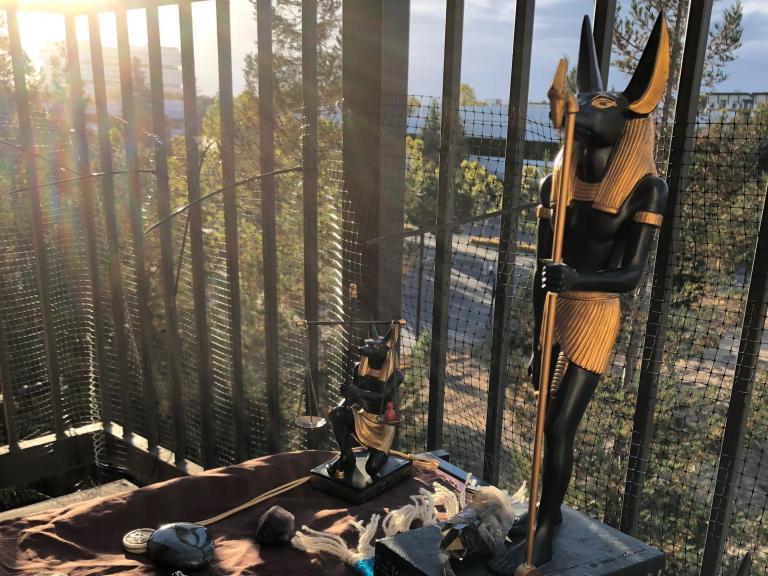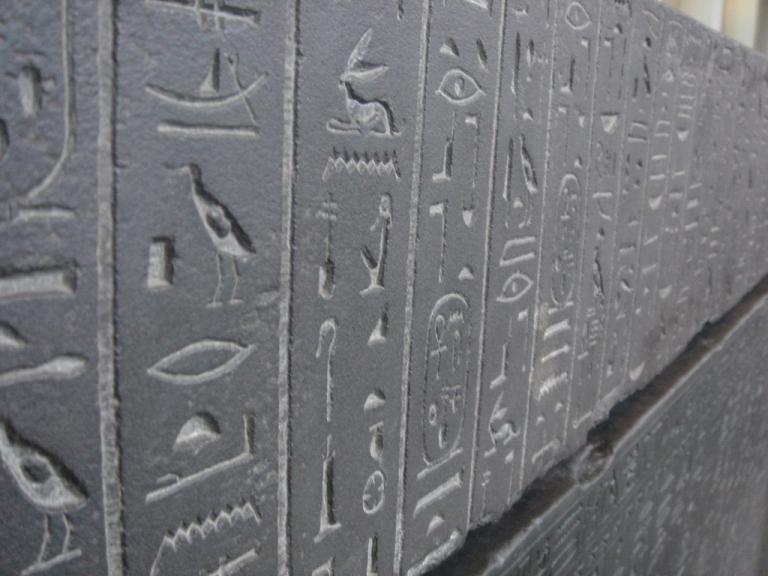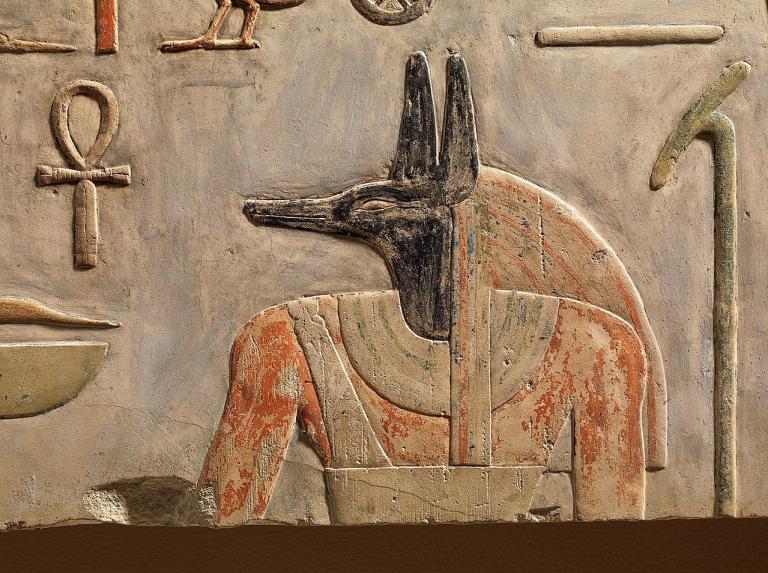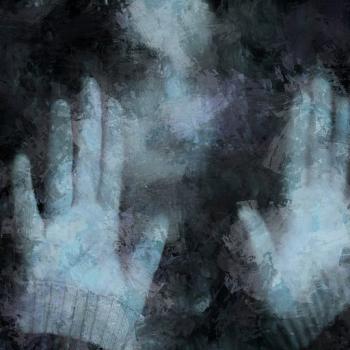You’ve gotten messages from Anubis. You’ve begun leaving offerings in honor of him. Perhaps you’ve even begun some transformational and emotional healing work with him. As you continue on your journey with Anubis and deepen your relationship with him, there may come a point in time where you may wish to create a sacred space to him. Setting up a sacred space is just one of many ways that you can deepen your practice with our chosen deity (Anubis, in this case).

A sacred space can be either physical or ethereal. A physical space would be something such as an altar or shrine set up in dedication to your chosen deity. An ethereal sacred space would be a space that you’ve created visually, in your mind’s eye or imagination, that you visit when doing any sort of meditational, astral, or journey work with Anubis (or your chosen deity).
While it’s entirely optional, if you choose to create a sacred space it can give you a focused place where you can honor Anubis as well as focus your intentions at the same time. It can give you a place where you can set aside other thoughts and feelings and let yourself connect with the energies, feelings, and thoughts needed at that given time.
Setting Up an Altar
The first thing I want to say before anything else is that altars do not have to be elaborate and filled with high-dollar items. In the day of social media, it’s easy to compare yourself to the trendy pagans and witches out there on Instagram. The important thing, I think, is to make it something meaningful that you feel represents your intended purpose for the altar.
If your intended purpose is to have an altar in dedication to Anubis, having some representation of him would be a key. If you wish to purchase a statue of Anubis of some sort, there are a wide variety of sizes, shapes, and colors ranging from low cost (we’re talking $5 or so) to high-dollar items. Feeling creative? Make one out of clay!
Artwork is another thing that people use in place of (or in conjunction with) a statue. You can definitely buy artwork, but you can always create your own! What better way to honor your deity than create something that you personally made yourself in their honor. Even a picture of a jackal or wolf will work, especially if you’re trying to be a bit more covert in your practice and devotion.
From there, it’s up to you what else you wish to add. Add a black candle (or white, if that’s what you have), a stone or two (smoky quartz or obsidian are great, though clear quartz or any black stone work, too), maybe an ankh. I am a firm believer in going with your intuition. There is, of course, a time and place for correspondences, but I think when it comes to honoring a deity, what feels right to you and makes you feel connected to that deity is what’s most important.

Creating an Ethereal Altar
This can be a little trickier, as it requires a bit of visualization, or at the very least, a bit of imagination and thought. The idea behind an ethereal altar is to create a space that you can visit when doing any kind of meditation, visualization, journeying, trance, or astral work where you are intending to connect with Anubis.
Similar principles apply to this as creating a physical altar – make it personal and meaningful. I think one of the most meaningful ways to do this is to take a little bit of a journey to discover what this space looks and feels like.
Sit down comfortably (or lie down, if that’s what you prefer), somewhere where you won’t be disturbed. Speak to Anubis, asking for his guidance as you discover your shared sacred space. I recommend speaking from the heart, but you may adapt this short prayer for your own use.
Anpu,
Great Guide to the Spirit Realm,
May your eyes pierce the darkness
To show me the way
To lead me to a sacred space
Where I may honor you
And connect to your energies and wisdom.
Protect me in this journey and in this space,
O Guardian.
Dua Anpu!
Close your eyes and take a deep breath, feeling that space in the center of your chest where your lungs expand. Hold it for a few seconds, and then release. Continue to breathe, feeling that space and then releasing it. Let yourself deepen into a relaxed state.
When you feel ready, let yourself explore, within your mind, your surroundings. These are all, of course, within your mind’s eye. What do you see? What does this space look like? How big is the space? What is made of? How is the lighting? What objects do you see? What colors surround you? Are there any figures or guides there with you? Do you hear anything or smell anything?

When You Can’t Meditate
Of course, not everyone can meditate in that way. There are different ways to meditate, each for different purposes. Many people have trouble with that kind of meditation, and that’s perfectly fine. There’s nothing wrong with that at all, and you don’t need to be able to do that kind of meditation to honor Anubis or even to create a sacred space in honor of him!
One alternative way would be to draw or paint it. Don’t worry if you’re not an artist. This is meant for you and Anubis. Sit down with a blank piece of paper and colored pencils, crayons, markers, chalk, or paint – whatever you prefer. Take a moment to take a few deep breaths and ask for Anubis’ guidance in creating this space. And then let your imagination take control!
Don’t think too much about it. Create what comes to mind without hesitation. Even if something comes to mind that you may not feel is immediately connected to Anubis, go with it. That’s the beauty of UPG (Unverified Personal Gnosis) – each of us has a unique experience with our deities that may or may not be the same as what others experience. Don’t feel that it has to fit within certain expectations or a certain look or feel to it.
Housekeeping and Revisiting
For a physical altar, cleaning your altar can be an act of devotion itself. Take time to remove things from the space. Clean the surface. Take some time to dust off any statues or objects that you have on your altar. Soft-bristled toothbrushes (clean) can work wonders for cleaning tiny cracks, ridges, and spaces. If you’ve got some non-corrosive oils, perhaps you can use them to polish and anoint the statue. Then, intentionally put back each item, reaffirming their place and meaning on your altar.
For your ethereal altar, the more you revisit it, the more it becomes ingrained in your mind and the stronger it becomes. Mentally revisit the things that you’ve discovered before. Go through the same steps you did the first time, asking yourself the same questions of what you see, hear, feel, smell, etc. You may discover new things that you didn’t notice before, the more you revisit it. Things may become more clearly defined, and you may notice details that you didn’t before. That’s part of the beauty of it, I think.
In the end, there’s no right or wrong way to create your sacred space. Whether you choose to create a physical altar, an ethereal space, or both, make sure that it’s something that is personal and intentional. There’s nothing that says it needs to look a certain way. There’s also no right or wrong way to create your ethereal space. Remember that not everyone can meditate and visualize things as easily, and there is absolutely nothing wrong with that. Work with your strengths, perhaps through creativity and imagination or through intentional design. Make it personal and meaningful!


















